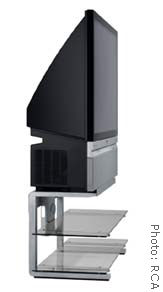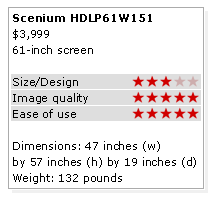NEW YORK (Money Magazine) - This is the TV that family rooms are built for. The new rear-projection TVs are nothing like their forebears, those old tavern staples that relied on three cathode-ray guns beaming blue, green and red to form images on the screen -- often so skewed that they produced rainbow effects.
 |
|
| RCA Scenium HDLP61W151 |
The best new sets rely on a technology called digital-light processing (DLP). With it, hundreds of thousands of mirrors built onto a microchip flip and rotate for each tiny picture element, or pixel, that's projected to the screen.
At 61 inches, the screen of the RCA Scenium HDLP61W151 is gigantic and bright. There's also a 50-inch version. And for its size, it's a veritable bantamweight, weighing 132 pounds. Unlike the old projection TVs that approximated the size of refrigerators, the Scenium is only 19 inches deep and does not require a giant base. That means you can set it on a solid table or television stand and put your components under it.
| Big Screen TVs
|

|
|
|
|
Most important, however, is the picture, which nears the quality of glass-tube sets, only much bigger. The effect is staggering. If you based your decision solely on the greatest number of people standing around a set at your local electronics retailer, the Scenium would win easily. Plus, priced at $3,999, it is far more family-friendly than flat-panels, which at this super size start north of $15,000.
About rear projection
Today's rear-projection TVs take up less space than the older cathode-ray-tube projection sets and have better picture quality.

There are two competing standards in high-definition rear-projection sets. Both produce exquisitely detailed pictures, but we prefer DLP, which is the technology used in digital projectors in movie theaters. DLP produces the brightest picture and offers the widest range of view. It's supported by Samsung and RCA, among others.
The other standard for projection sets uses liquid crystal display (or LCD) technology, the same stuff used in flat-panel computer displays. These sets (by Sony, Hitachi and others) tend to produce more saturated color, which some find tiring on the eyes.

|

